Mt. Bachelor, Oregon is one of those ski destinations that captured my imagination for many years. There’s just something about the idea of skiing 360 degrees off the top of a 9000’ white volcano that blows my mind. In the last three days of December 2012 my son Vince and I got a chance to enjoy this exotic ski experience in all its glory. Due to an exceptionally snowy early season all 3700 acres of this mountain were in play during our visit. A fellow snowrider told us our dates coincided with the third, fourth and fifth days of the season that the entire layout was open from the summit and we took advantage of this with multiple summit runs each day.
Mt. Bachelor is really two ski areas. The front side of the mountain skis like a conventional lift served ski area, albeit a big one with 12 lifts (including six express chairs), 71 designated runs (1600 acres of groomers), numerous glades, a vertical drop of approximately 3300’. There are three major on-mountain lodges serving the front side.
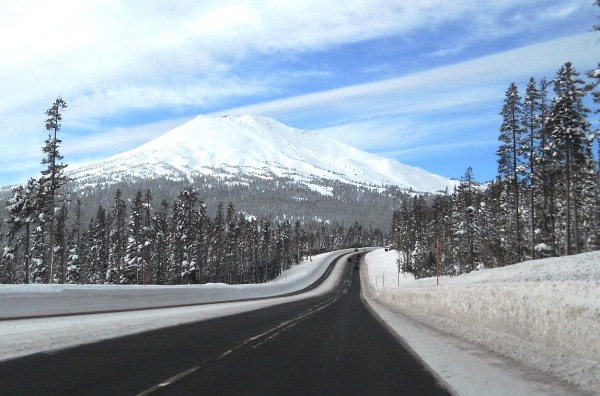
|
|
Approaching the front side of Mt. Bachelor, Oregon. Photo provided by Jim Kenney.
|
The back side of Mt. Bachelor is like another planet; largely treeless except for frozen hoodoos and representing nearly half of the ski area’s total skiable acres with bowl after bowl fanning out from the summit in a consistent single black diamond pitch with totally ungroomed snow surfaces - naturally. Vertical drops on the back side range from about 2000’ in the Eastward direction towards the Rainbow Chair lift to pretty much the entire 3300’ in the westward direction to the base of the Northwest Express Chair. Depending on where you descend the back side and intersect the catchline gravity is your guide in choosing to ski either east or west returning to the lifts. The cat track that runs in parallel with the catchline is approximately five miles long. Confirming my preconceptions, the scale of the back side all-natural terrain at Mt. Bachelor is mind blowing.
But let me start at the beginning. We were super stoked driving up to the mountain. It was a beautiful clear late December day when we got our first peek at the peak about 20 miles out at mid-morning. It was like a giant glowing white Hershey’s Kiss. When we got within a couple miles I asked Vince if his young eyes could make out whether the summit express chair (1725’ vertical) was running. It was! The stoke meter went off the charts.
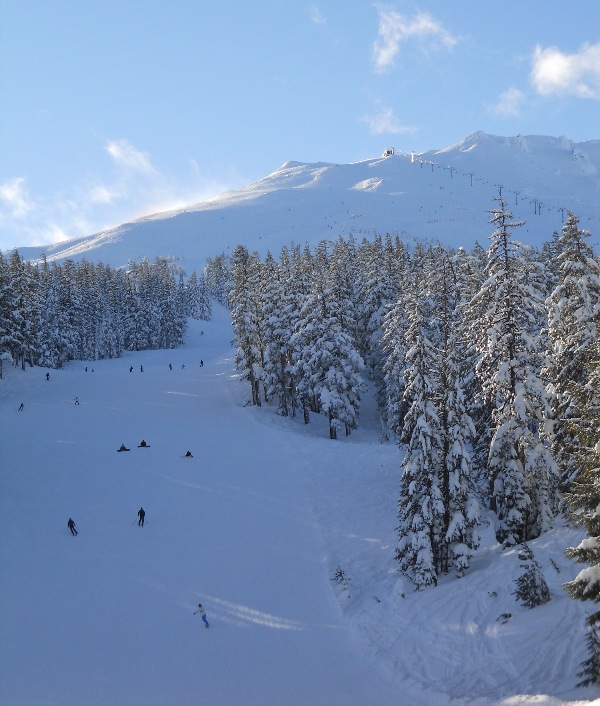
|
|
Summit view from the groomed runs near Rainbow Chair. Photo provided by Jim Kenney.
|
One thing I have learned in my travels reporting for DCSki is that when a ski area’s signature feature is open and available -; hit it and photograph it immediately. You never know when a white-out, a wind hold, or a creaky knee joint will preclude access to the good stuff for the rest of a visit. Therefore, outside the West Village Base Lodge we quickly latched on to a friendly young man visiting from Sacramento, CA who knew the resort and agreed to lead us on our very first two lift rides straight to the summit.
When we got there the Californian started climbing the final 50-100 vertical feet to the highest point on Mt. Bachelor (9065’) fulfilling a promise he had made to launch himself off the summit cornice into Cirque Bowl, the steepest double diamond pitch on Mt. Bachelor. Since it was our first moments at altitude and I’m an old guy we passed on the hike and instead traversed from the upper chairlift terminus to the center of the Cirque and skied all the way down through the heart of the front side of the trail layout. The view to skiers left of nearby volcanic peaks Broken Top Mountain (9175’) and the Three Sisters Mountains (each exceeding 10,000’) was breathtaking and unlike anything I’d seen in my ski travels. It wasn’t so much a range of mountains, as a spray of huge volcanic bumps protruding across a forested wilderness as far as the eye could see.
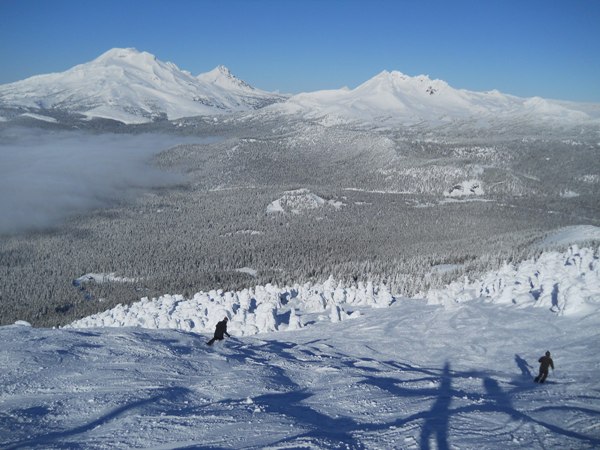
|
|
Mogul bumps and Volcanic bumps (the Sisters and Broken Top mountains). Photo provided by Jim Kenney.
|
Over the span of the next three days we tried our best to sample runs from all lifts. The lookers left of the front side of the mountain features the Rainbow Triple Chair (1215’ vertical) and the Sunrise Express Quad (808’ vertical) serving beautiful blue square and dark green circle groomers. The center of the front side has longer and slightly steeper groomers served by the Skyliner Express Quad (1316’ vertical) and the Pine Marten Express Quad (1360’ vertical). The latter terminates at the large Pine Marten Lodge high up on the mountain at elevation 7775’, our choice for a convenient and scenic lunch break each day.
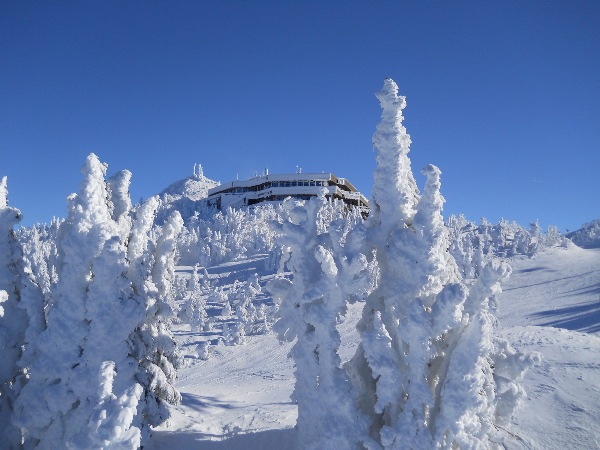
|
|
View of the Pine Marten Lodge from Outback Express Chair. Photo provided by Jim Kenney.
|
To the looker’s right on the front side of the mountain the runs continue to steepen and grow longer and wilder. There are two tremendous express quads here called Outback and Northwest that rise 1780 and 2365 vertical feet respectively. These two chairs alone make Mt. Bachelor a fine destination for advanced skiers/riders and feature steep groomers, bumps, ungroomed bowls, and awesome, endless glades.
Besides the huge potential for “side country” exploration and a reputation for extra long ski seasons with outstanding early and late winter conditions, the third quality I had heard about Mt. Bachelor prior to my visit was its excellent glade skiing. As a testimony to the size of the place we didn’t really stumble on to a prime example of this until our third day. Let me tell you that over by the boundary where the designated runs served by the Northwest Express Quad end and the wild back side of the mountain begins there are magnificent black diamond glades.
Vince and I made a continuous glade run to the skiers left of the Northwest Express Quad (2365’ vertical) that must have dropped close to 2000 vertical feet. We did it at 1:30 PM on New Year’s Eve in complete and total solitude. Initially these glades (West Bowl?) started tight with single and double diamond steepness, but then lessened to a lower angle dark blue square pitch with wider tree spacing. In the beauty and silence of those hemlock and lodgepole evergreens I thought of my glade-loving ski buddy Rob Davis from western Pennsylvania. The snow was dry, soft and forgiving. We didn’t see another soul the entire run. The Northwest Express was installed about 15 years ago and made this section of the mountain a tree skiing heaven.
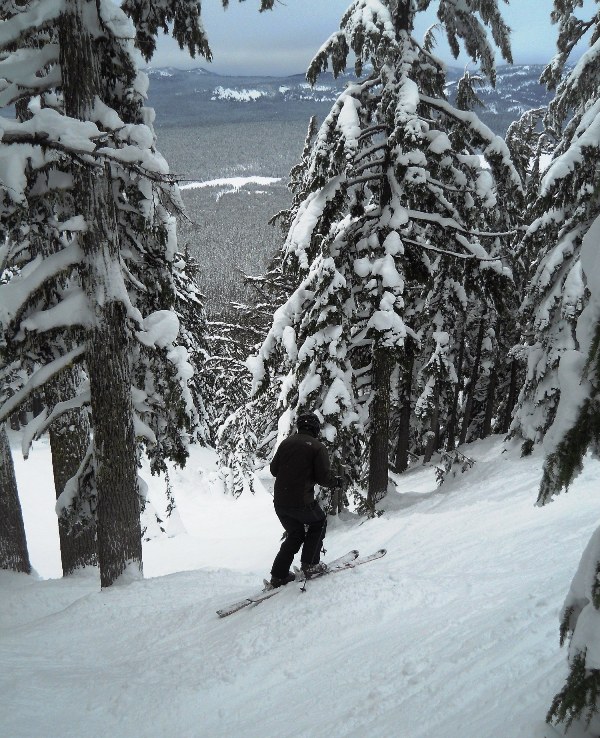
|
|
The endless Northwest glades. Photo provided by Jim Kenney.
|
I want to spend more ink on the summit runs because for a destination skier/snowboarder at Mt. Bachelor they are a fantastic and distinctive drawing card. Assuming the mountain is a watch dial and straight down the front face is 12 O’clock, then some of our summit runs were at 12, 2, 3, 5, 7 and 9 O’clock on the dial. Sometimes we just followed our noses and once got slowed to a crawl in a steep, narrow gulch full of tight trees. Other times we would cajole locals into showing us interesting, non-intuitive routes down from the summit.
Our summit run down 12 O’clock on the mountain’s dial began from the top of the Summit Express Chair with a traverse skier’s left across the upper reaches of the mountain and then straight through the totally treeless Cirque for about 1300 vertical feet to the top of the rest of the front side lift served terrain and 2000 more vertical feet. 2 was down Healy Heights, a huge open slope marked as a blue square on the front side trail map and the most doable run from the summit for strong intermediates. In my opinion just about every other route from the summit was black diamond in difficulty due to highly variable snow conditions. 3 was down Cow’s Face and East Bowl while being led by Justin, a friendly local, through some thin glades featuring a mix of funky and great soft snow. 5 was down the back side via either Larry or Moe Valley (them and Curly Bowl all look the same to a tourist) bedecked with thousands of spooky frozen hoodoos or snow-encased trees. 7 was a long traverse skier’s right across the top of the back side of the mountain and down another huge bowl, perhaps Deadwood Canyon, into a tight gulch full of trees nearly dead-ending before finally breaking through to the catchline. 9 started with a long, high traverse shown to us again by Justin from La Pine, OR across the entire front of the summit and then down an open snowfield with very mixed conditions including bathtub size slabs of snow/ice, then on to groomers to the base of the Northwest Express Quad for Mt. Bachelor’s full 3300’ vertical drop.
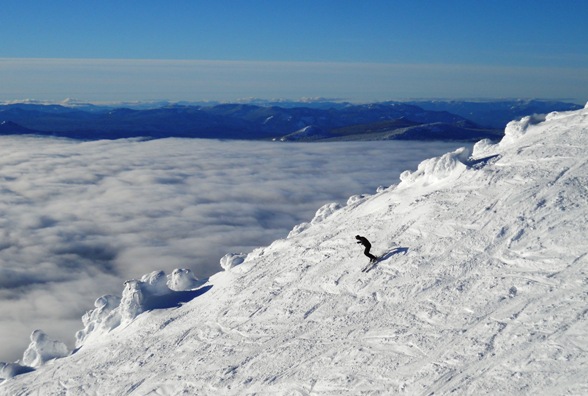
|
|
The Upper Plains on the back side of Mt. Bachelor. Photo provided by Jim Kenney.
|
At this point I’d like to dispel the Mt. Flatchelor myth. Summit skiing may not be steep to the extreme, but the exposure and snowy climate can make for very challenging and highly variable snow conditions. We saw mostly soft, forgiving crud on the backside during our visit, but also ice chunks, wind slab, and fluffy old powder leading to steep chutes, tight glades, and very narrow gullies. For advanced skiers and snowboarders this is thrilling, off-piste skiing on a grand scale and will call upon every skill in a snowrider’s bag of tricks.
We stayed in the city of Bend (population 80,000) during our visit to Mt. Bachelor. Purportedly, it has about 20 craft breweries, including Deschutes Brewery, a big regional player with an output of about a quarter million barrels per year. We were hacking and coughing with colds the whole time in Oregon so I wasn’t in the mood for a beer fest, but I did notice how easy it was to adjust to the altitude even with a compromised respiratory system. Mt. Bachelor is at the latitude of about 44 degrees and is further north than Sun Valley, Jackson Hole, or Killington. It’s far enough from the Pacific Ocean to catch a little dryer variety of snow than the rest of the Cascade Range. The lowest point of the ski terrain is 5700’, less than a thousand feet higher than the summit of Snowshoe, WV. These geographic characteristics make it a snowy, yet hospitable location for vacationing flatlanders.
The environment around Mt. Bachelor has a pristine, natural quality. There is no true resort village or slopeside overnight lodging because the entire ski area is surrounded by two million acres of the Deschutes National Forest. The 20 mile drive from a plethora of accommodations in Bend is accomplished via the Cascade Lakes divided four lane highway, one of the best maintained ski area access roads you’ll ever see and a very gentle climb from town.
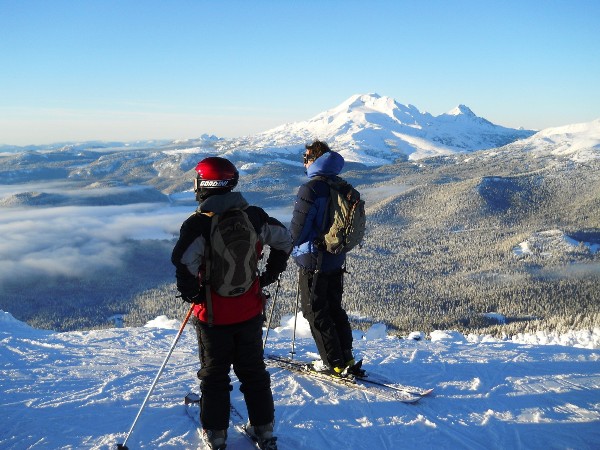
|
|
Enjoying an unspoilt late day view at Mt. Bachelor. Photo provided by Jim Kenney.
|
Being crazy road trip warriors, Vince and I drove from San Francisco to Mt. Bachelor in about eight hours, but many destination visitors use the Redmond, OR airport (~1 hour) or the Portland, OR airport (~3.5 hours). Mt. Bachelor draws guests from throughout the Pacific Northwest, Northern California, and a fair number of Easterners. Bend’s ascendancy as a 21st century vacation/retirement location is well known due to a temperate location on the border of the high Oregon desert and the Cascade Range.
There were considerable New Year’s Weekend crowds on the mountain during our visit, but only a few lifts near the primary base lodges saw notable lines and we used “singles” lanes to move through them in a couple of minutes. Snow conditions were excellent; packed powder on the groomers and soft loose snow for the most part in the off-piste. Mt. Bacheler already had over 100 inches of snow base by late December. Temperatures were in the single digits at night and around 20-25F during the day. We saw no appreciable new snow during our visit with one overcast day and two gloriously sunny, windless days. There was one afternoon when a snow squall passed over the mountain greatly reducing visibility for about an hour and it struck me how fortunate we were to experience this huge mountain totally open with all lifts running during our three days. I bought a cool souvenir from the Mt. Bachelor ski shop, a 16 ounce pint glass emblazoned with the ski area logo. It’s made of unbreakable silicon and includes the catch phrase -; Naturally.
Husband, father and retired civilian employee of the Department of Navy, Jim Kenney is a D.C. area native and has been skiing recreationally since 1967. Jim's ski reporting garnered the 2009 West Virginia Division of Tourism's Stars of the Industry Award for Best Web/Internet/E-Magazine Article.